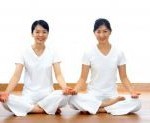 By Gopi Rao
By Gopi Rao
Why are pranayama techniques important? Often underrated, pranayama is the fourth limb mentioned within Patanjali’s Yoga Sutra. Pranayama refers to the deep and deliberate breathing associated with yoga. More specifically, pranayama is a Sanskrit word meaning “control of the life force.” Pranayama is often referred to as breath control, or yogic breathing. Pranayama techniques are beneficial in keeping the heart, lungs, and body healthy.
Bhastrika Pranayama
Bhastrika pranayama directly affects the lungs, and is often recommended for ailments associated with the respiratory system. While no cures are promised, Bhastrika should be practiced every day, from two minutes to five minutes. To perform Bhastrika, sit in a comfortable position with a straight spine. Breathe in through the nose forcefully, filling up the lungs completely, then immediately and with equal force release the air from the lungs. Repeat the process several times, stopping if you feel tired.
Kapalbhati Pranayama
Kapalbhati is a shatkarma and possibly the most well known of all pranayama techniques. Kapalbhati will improve the health of the entire body, and can even aid with ailments of all kinds. However, it is a dynamic yoga technique and is not suggested in cases when a student has a hernia. The pace of Kapalbhati can be slowed down to meet the needs of students who need restorative pranayama techniques, It is best to practice Kapalbhati in the morning, on an empty stomach. Sit comfortably with a straight spine. To practice Kapalbhati pranayama, inhale normally and exhale forcefully. Use the abdominal muscles to pull the air in and push it out. As you exhale, it is helpful to visualize you are throwing all of the negative energy, disease, anger, or stress from the body.
Bahya Pranayama
Bahya is helpful for all of the stomach’s organs as it massages the internal organs by using the lungs to compress against surrounding organs. Sit comfortably in Easy pose. For the dynamic version: Breathe in deeply, then push all of the air completely out of the lungs. Then, with the breath still “outside” the body, touch your chin to your chest and pull up the diaphragm and groin muscles, holding for up to 10 to 15 seconds. Carefully, release the groin, diaphragm and chin one by one and breathe normally to complete the pranayama. Repeat one to three times a day. For students who need to go easy, slow everything down, do not force, and avoid breath retention.The point being: You can customize all of the pranayama techniques to meet the needs of your mind and body.
Ujjayi Pranayama
Ujjayi pranayama is practiced for many reasons, but few people realize this powerful technique can be practiced gently before bedtime and some people get a good night’s sleep. To practice: Sit in a comfortable position. Take a long, thin breath by constricting the throat while you inhale through both nostrils. This will produce a hissing sound as the air travels through the throat. Then, exhale slowly, and repeat three times a day. After a few days’ practice, you can hold your breath in after the slow inhale and touch the chin to the side of the chest and hold for up to 10 seconds. One again, breath retention is an option, not a requirement. Students with high blood pressure, heart problems, or who are pregnant are advised to avoid breath retention.
© Copyright – Aura Wellness Center – Publications Division
To see our selection of Yoga teacher training courses, please visit the following link.
https://aurawellnesscenter.com/store/
Click here too see our online Yoga Nidra teacher training course.
Are you an experienced teacher looking for YACEP credits or continuing education?
Subscribe to Our Newsletter for Special Discounts and New Products
Related Resources
52 Essential Principles of Yoga Philosophy to Deepen your Practice
by Rina Jakubowicz.
A Relaxing Way to De-stress, Re-energize, and Find Balance
by: Gail Boorstein Grossman.
YOGA: THE PATH TO HOLISTIC HEALTH
by B.K.S. Iyengar
TEACHING YOGA: Essential Foundations and Techniques
By Mark Stephens
Nivethitha L, Mooventhan A, Manjunath NK. Effects of various Prāṇāyāma on cardiovascular and autonomic variables. Anc Sci Life. 2016;36:72–7.
Anitha A. Effectiveness of pranayama on level of anxiety among clients with myocardial infarction. Res J Pharm Biol Chem Sci. 2016;7:2857–9.
Sharma VK, Trakroo M, Subramaniam V, Rajajeyakumar M, Bhavanani AB, Sahai A. Effect of fast and slow pranayama on perceived stress and cardiovascular parameters in young health-care students. Int J Yoga. 2013;6:104–10.
Mobini Bidgoli M, Taghadosi M, Gilasi H, Farokhian A. The effect of sukha pranayama on anxiety in patients undergoing coronary angiography: A single -blind randomized controlled trial. J Cardiovasc Thorac Res. 2016;8:170–5.
National Center for Complementary and Integrative Health. Strategic Plan 2016: Exploring the Science of Complementary and Integrative Health. Maryland: National Center for Complementary and Integrative Health; 2016.
Saxena T, Saxena M. The effect of various breathing exercises (pranayama) in patients with bronchial asthma of mild to moderate severity. Int J Yoga. 2009;2:22–5.
Woodyard C. Exploring the therapeutic effects of yoga and its ability to increase quality of life. Int J Yoga. 2011;4:49–54.
Yang K. A review of yoga programs for four leading risk factors of chronic diseases. Evid Based Complement Alternat Med. 2007;4:487–91.
Joshi KS. Yogic Pranayama: Breathing for Long Life and Good Health. India: Orient Paperbacks; 2006.
Sharma VK, Rajajeyakumar M, Velkumary S, Subramanian SK, Bhavanani AB, Madanmohan, et al. Effect of fast and slow pranayama practice on cognitive functions in healthy volunteers. J Clin Diagn Res. 2014;8:10–3.
Bhatt A, Rampallivar S. Effect of pranayam on ventilatory functions in patients of bronchial asthma. J Evol Med Dent Sci. 2016;5:1453–55.

Pranayama techniquess are beneficial in keeping the body healthy and free of toxins. Thanks for sharing this informative article.